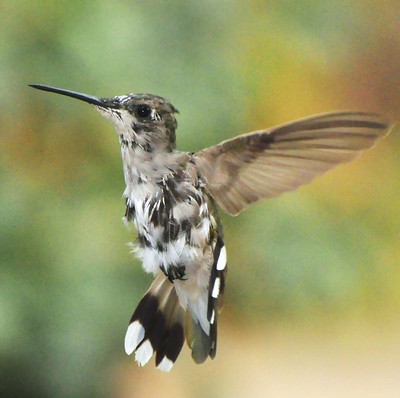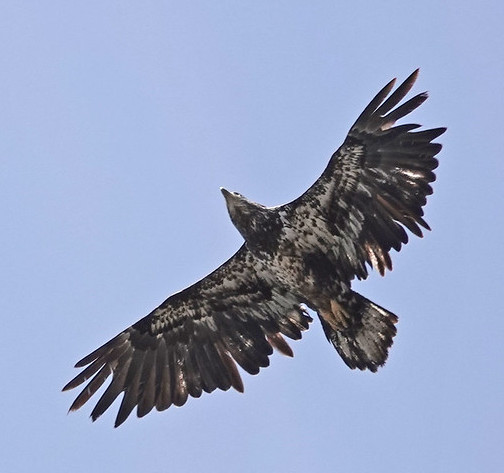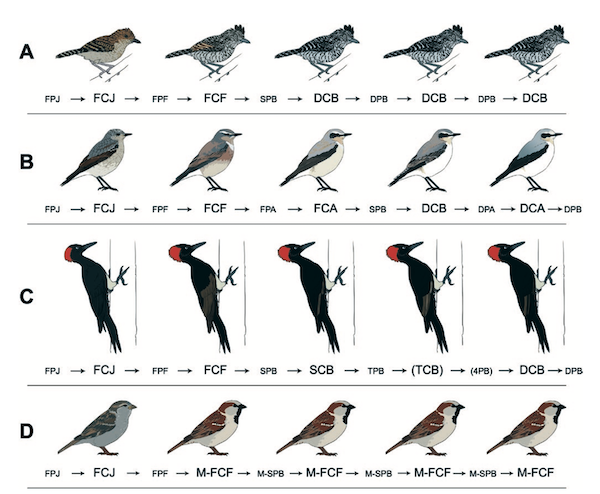
A molting hummingbird. Photo by Jeffryw/Flickr
Age isn’t everything, but it’s a lot. Being able to define, or describe, the age of a bird is pretty fundamental to understanding it. On an individual level, age can help explain a bird’s behavior. Is it a juvenile begging for food or a young adult that’s unlikely to breed for another couple of years? On a population level, the ages of individuals can tell you a lot about its health. An aging population with few young individuals may be experiencing a reproductive failure. A population with too few mature adults may face survivorship or other problems.
So scientists developed age classification systems for birds, most of which were based on the human calendar, for example “hatch year” and “second year,” or the seasons of the north-temperate zone. But as you move towards the equator these systems tend to fall apart. In a paper published recently in the journal Ornithology IBP biologist Peter Pyle and co-authors make a case for using the WRP (Wolfe-Ryder-Pyle) age-coding system which is based on the molt-cycle. Pyle explains why older ageing systems don’t work well across latitudes:
“Seasonal-based codes are very boreal-centric, that is, they work fine at northern latitudes where breeding seasons are well defined and occur almost universally during the summer months. However, as you make your way toward the equator breeding seasons break down and, increasingly, we see extended or year-round breeding. By the time you reach higher southern latitudes, breeding occurs across our Northern Hemisphere winter. Such coding as "HY" for hatching-year or "SY" for second (calendar) year cannot be used effectively for birds that can hatch either side of January 1st, the determining factor for such coding.”

A molting eagle. Photo by David Moulton/Flickr
But all birds molt and virtually all molt cycles are annual- even in equatorial birds. Tying an ageing system to this universal physiological cycle makes the system more widely applicable and consistent. Another benefit? It allows for more meaningful comparison between species and collaboration between scientists. But it’s sometimes hard to teach an old ornithologist, bird bander, or bird-watcher new tricks.
The WRP system uses the molts and plumages defined by Humphrey and Parkes in 1959 and modified by Howell in 2003 with which many banders and scientists are already familiar. WRP age codes consist of 3 letters: the first letter indicates the cycle or age of the bird, the second letter indicates molt status of the bird, and the third letter indicates the plumage of the bird. In the most recent paper, Pyle and co-authors refine definitions of some of the current WRP codes, add optional adjunct codes, and add a few new codes that cover rarer molt strategies.
Since its initial introduction in 2010, the WRP system is gaining widespread acceptance. Bird banders and ornithologists in the Neotropics were among the first to adopt the system followed by colleagues in North America, Asia, Afrotropical regions, and elsewhere. However, Pyle notes:
The biggest hurdle is adoption in Europe, where an entirely different molt and plumage terminology (the "life-cycle system") is used. Presently Europeans are having a hard time accepting or adjusting to the Humphrey-Parkes system, upon which the WRP system is based. But my hope is that younger generations will see the value of an evolutionary approach to defining molts and plumages and of comparing molt strategies on a global basis, and that WRP will some day gain wider usage in Europe, even if it takes decades.
Pyle advises that learning the Humphrey-Parks terminology and sticking to it really makes molts and plumages easier to understand. IBP provides some great resources for learning this terminology and the WRP system, which are linked below this article. Pyle and co-authors are grateful for all the dedicated bird banders, ringers, and birders who have taken the time to learn the WRP system and provide feedback that has improved it. IBP executive director Rodney Siegel comments, “IBP has always taken a global approach to bird conservation, but the older bird aging systems were really biased towards temperate North America. Adoption of the WRP system will allow consistency between IBP’s two signature bird monitoring programs, MAPS and MoSI, and help foster communication and collaboration between researchers studying birds all over the world.”
RESOURCES:

A molting goldfinch. Photo by Billtacular/Flickr.
The following MAPS Chat issues each contain an article about using the WRP system:






